Contents
- 1 Why Is Thermal Management Vital For Your PCB?
- 2 What are PCB Thermal Management Techniques?
- 2.1 Use the correct thermal management PCB materials.
- 2.2 High power, no temperature cycling
- 2.3 High-temperature cycling
- 2.4 High ambient temperature
- 2.5 Consider heat sinks in your PCB design
- 2.6 Use heat pipes in PCBs with limited space
- 2.7 Include cooling fans in your PCB design
- 2.8 Employ thick copper traces for maximum heat loss
- 2.9 Utilize thermal via arrays in your PCB design
- 3 Save Time in the Long Run With Thermal Simulations
- 4 Work With a PCB Assembly Service for the Best Results
Why Is Thermal Management Vital For Your PCB?
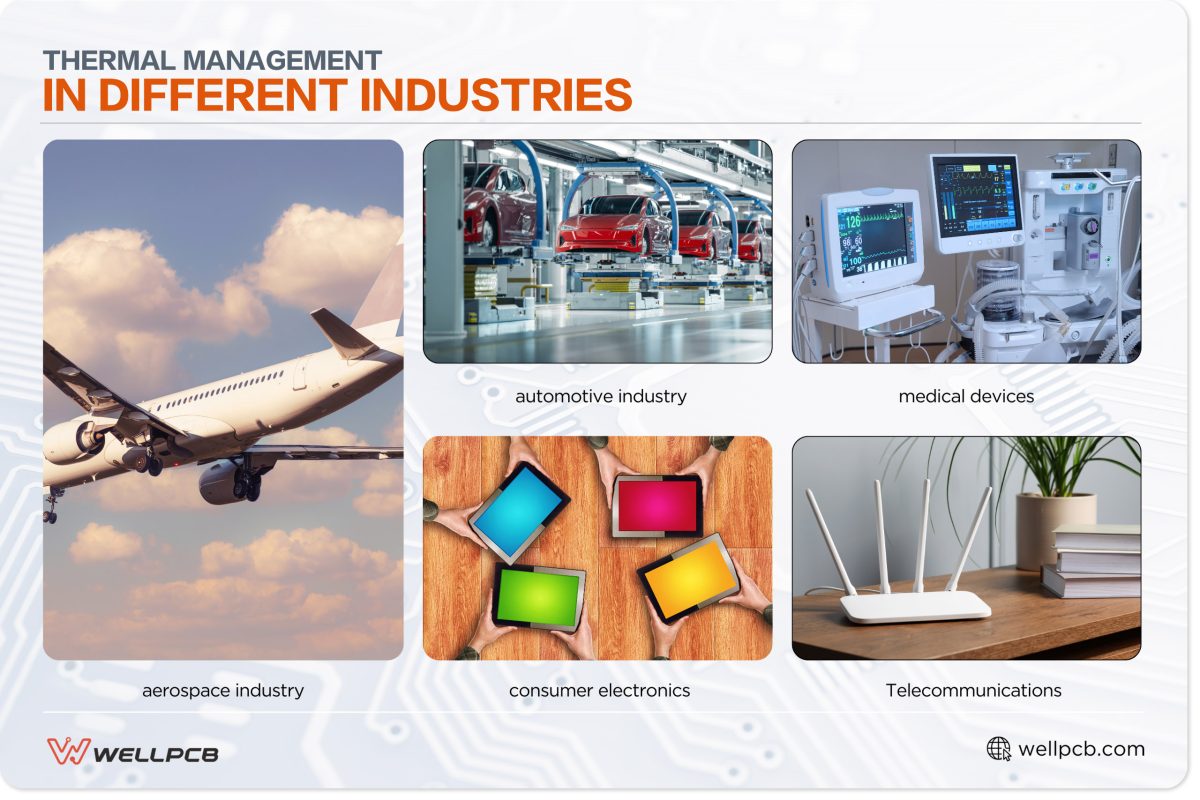
The demand for miniaturization, technological advances, and innovative designs has led to smaller, more complex, and denser PCBs with higher power requirements. These compact designs increase the risk of heat buildup, which can lead to serious issues with overheating.
Overheating is a significant concern, as it can compromise the performance, safety, and reliability of electronic devices. To address this challenge, metal cores are often used in PCB construction to enhance heat dissipation and ensure stable operation, particularly in high-power applications.
This is unacceptable in many industries:
- Aerospace: Aerospace applications demand robust thermal management to handle the extremely high temperatures of onboard electronics, communication systems, and avionics.
- Automotive: In automobiles, components like power electronics, control units, and sensors operate in high-heat conditions. Proper thermal management of PCBs is critical to ensure safety, reliability, performance, and efficiency.
- Medical devices: Accurate and continuous functionality in medical devices is critical to patient outcomes and well-being. As such, precise thermal management of sensitive electronics, imaging equipment, diagnostic tools, and patient monitoring systems is vital.
- Consumer electronics: Devices such as laptops, smartphones, and gaming consoles need efficient thermal management to prevent overheating, which can cause performance throttling and shorten their lifespan.
- Telecommunications: For reliable and uninterrupted communication in telecommunication infrastructure and data centers, performance throttling must be avoided in networking devices like servers, switches, and routers. This requires robust thermal management.
What are PCB Thermal Management Techniques?
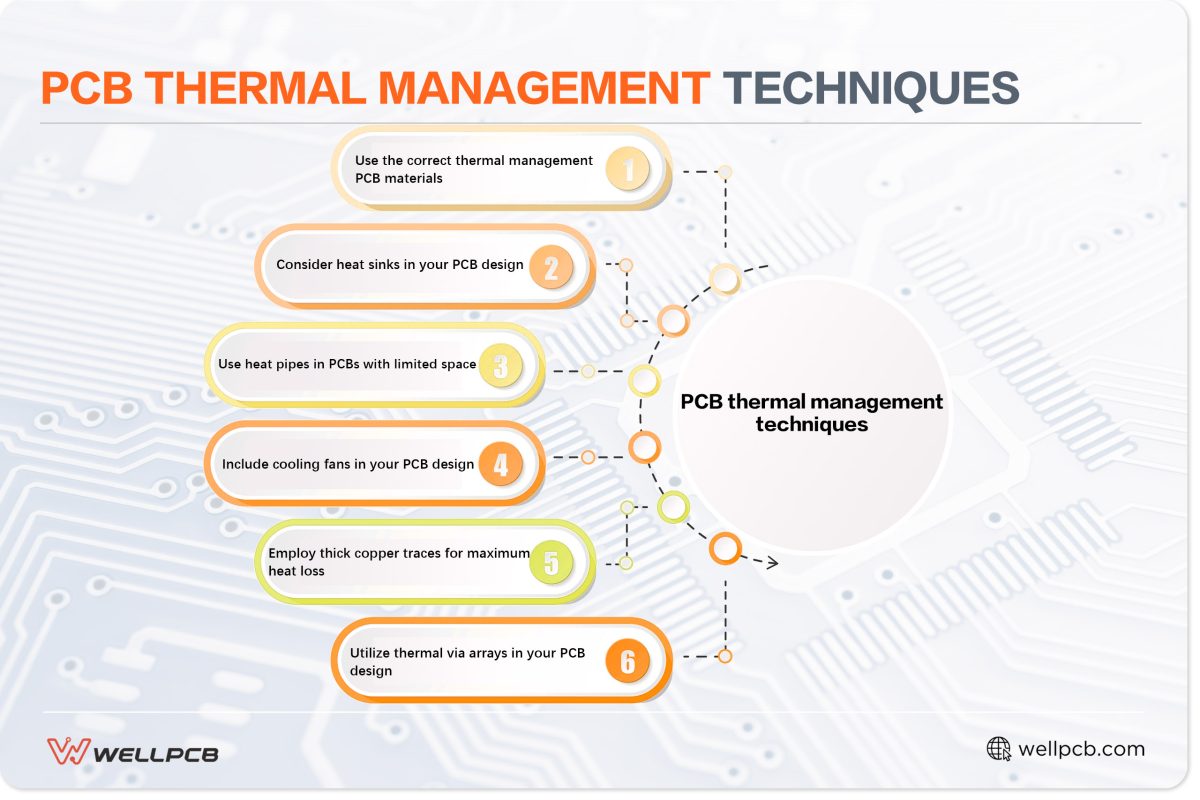
While passive cooling measures benefit PCB heat management, this is not possible for all products. Each component is a source of heat for PCBs with many active components.
Therefore, many active components operating together at high speeds will generate significant heat and raise the device’s temperature.
In such cases, active cooling components are unavoidable.
Use the correct thermal management PCB materials.
Designers often prefer passive cooling methods, focusing primarily on selecting the right PCB materials. Material selection depends on three key parameters:
Material properties vary depending on the board’s operating conditions, typically falling into three scenarios.
High power, no temperature cycling
When PCB components run continuously at high power without significant variation in temperatures, laminate materials that act as heat spreaders are ideal. The laminate must spread heat to lower the temperature of these high-power components. Materials like ceramics and metal cores, known for their high thermal conductivity, help dissipate heat effectively.
High-temperature cycling
In environments with repeated temperature cycling between high and low values, the CTE of the laminate becomes crucial. A mismatch in CTE can put stress on the copper features, leading to potential fatigue failure, especially around vias. To minimize stress, low CTE mismatch materials like specialized FR4 and engineered PTFE are recommended.
High ambient temperature
For PCB boards exposed to high ambient temperatures, rather than high-powered components, materials must function as heat spreaders. That said, high thermal conductivity is not necessary. Standard FR4 with heavy copper layers works well in these conditions. In these systems, designers may also use active cooling systems that target specific components.
In the above scenarios, the glass transition temperature (Tg) should be high enough to exceed the board’s operating temperature. This is the basic thermal management requirement for PCBs working in high-temperature environments, or that experience high temperatures from high-power components.
Consider heat sinks in your PCB design
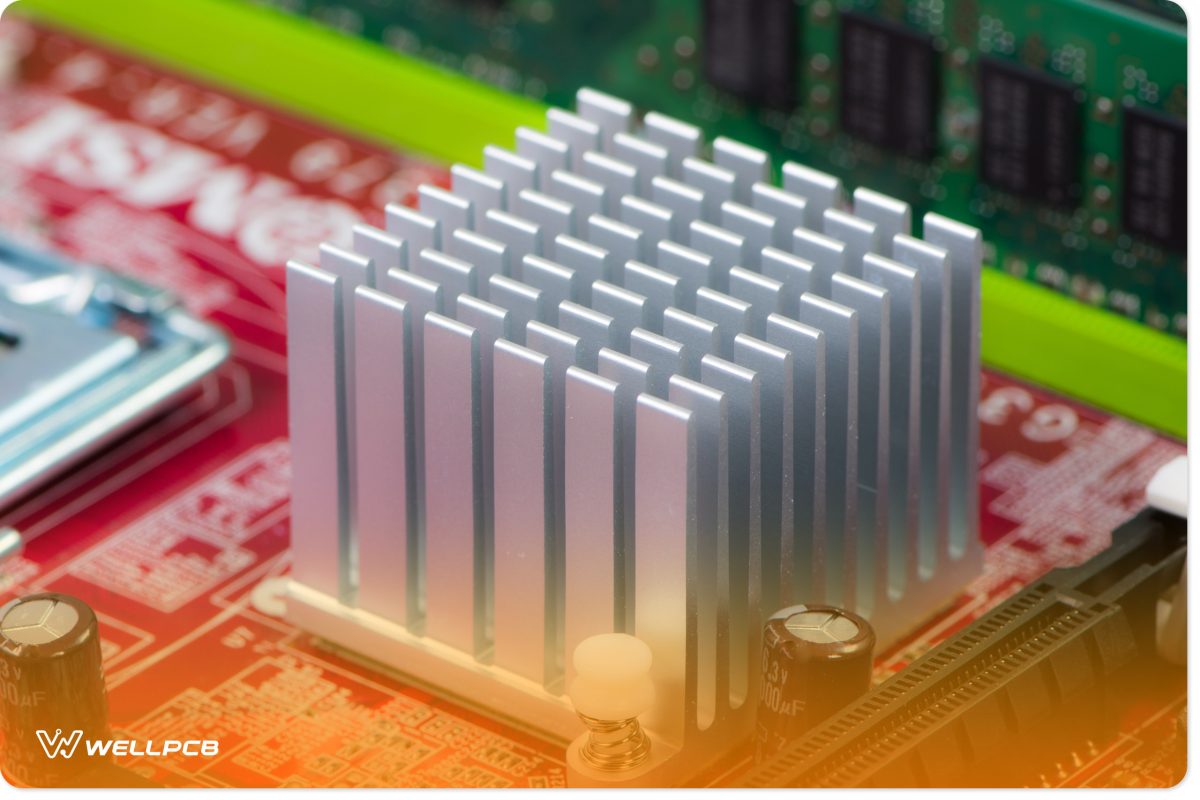
In high-temperature PCBs, the material used in the PCB fabrication process can function as a heat sink. In such cases, the laminate material acts as a heat spreader, distributing heat to different areas for efficient dissipation. The table below outlines common PCB laminate materials that are suitable for high-temperature PCB boards.
| PCB Material type | Examples | Benefits |
| Metal-core PCB | Core aluminum Aluminum-backed | Effective heat spreading (Core aluminum) Cost-effective High reliability (Aluminum-backed) |
| Ceramic substrates | Aluminum oxide (Al₂O₃) Aluminum nitride (AlN) Silicon carbide (SiC) Beryllium oxide (BeO) Boron nitride (BN) | Thermal conductivity 20x to 100x that of FR-4 Effective heat spreaders |
| Heavy copper | Rolled foils (various weights) Direct plating for high-weights | Reduces DC resistance of traces Thick copper planes facilitate easy heat spreading |
| PTFE-based PCB laminates | Rogers AGC materials (Taconic, Nelco) Arlon | Low CTE mismatch to copper Higher glass transition temperature than FR-4 Supports advanced RF and high-speed systems |
| Polyimide | Various polyimide blends | Suitable for high-temperature flex PCBs Higher glass transition temperature than FR-4 |
Use heat pipes in PCBs with limited space
Heat pipes are sealed hollow tubes made of copper or aluminum-containing a working fluid like water, ammonia, or alcohol. A wick structure lining the inner surface of the pipes helps transport this working fluid.
The working fluid absorbs heat at one end (evaporator) and moves towards the cooler end (condenser) as vapor. The vapor then cools, condensing back into liquid and releasing the absorbed heat. The wick structure’s capillary action returns the liquid to the evaporator, enabling efficient heat transfer without active cooling.
As heat pipes have high thermal conductivity, they facilitate heat transfer over long distances in compact PCBs. Their slim design also makes heat pipes a better fit for tight spaces. As they operate passively without any moving parts, they require no external power support and produce no noise.
Include cooling fans in your PCB design
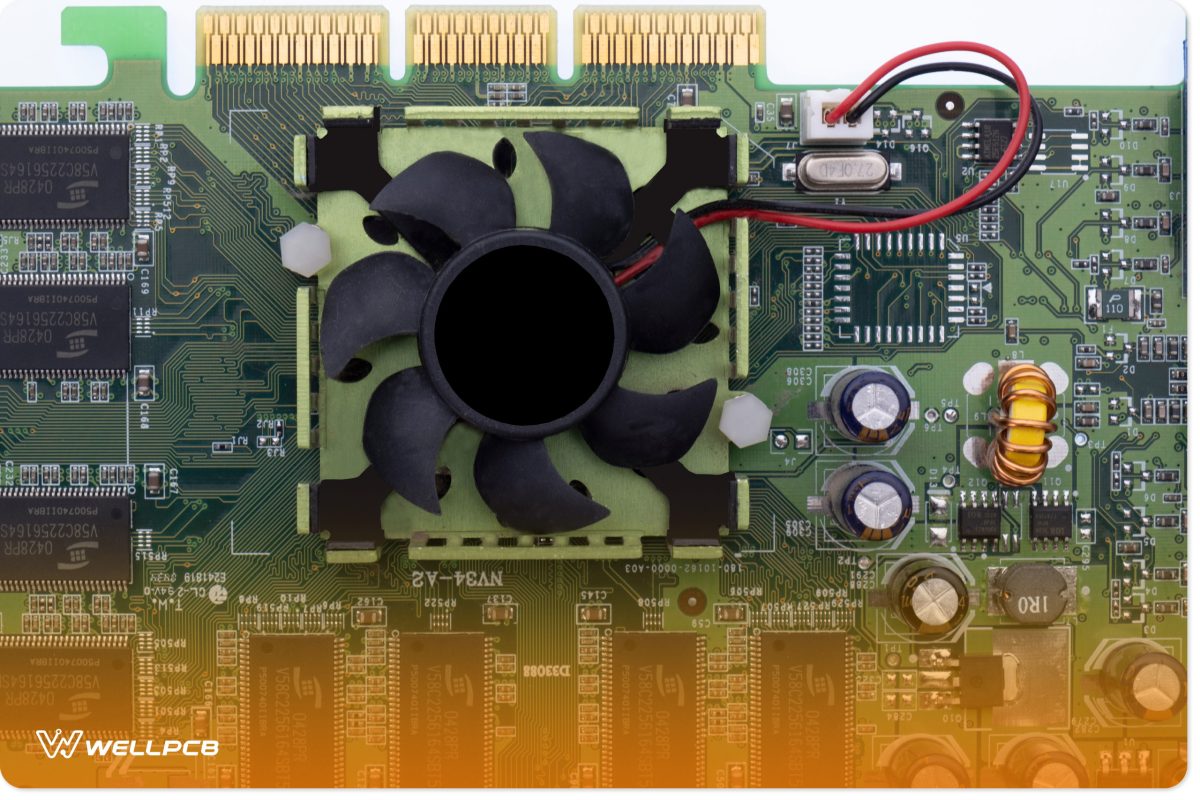
Cooling fans use an electric motor to rotate blades, creating airflow that draws heat away from hot components and distributes it across the circuit board.
As airflow around the PCB increases, heat that would be absorbed by the PCB is instead displaced by moving air. If air isn’t moving, a layer of stagnant air hinders heat dissipation, leading to a rise in temperature. By circulating air, fans help prevent component overheating.
By maintaining optimal operating temperatures and efficient heat dissipation, cooling fans ensure the reliability and performance stability of high-powered PCBs.
Employ thick copper traces for maximum heat loss
The dielectric constant of traces in one layer is influenced by the layer stack of the PCB, which in turn affects the trace impedance in the circuit board.
Managing the layer stack is an effective way to reduce the overall thermal resistance of the PCB. This helps move heat away from the active components, vias, and traces.
Proper layer stacking involves arranging power and ground layers effectively.
As plane layers are made of copper or other conductors, they have low thermal resistance—allowing efficient heat transfer across the board.
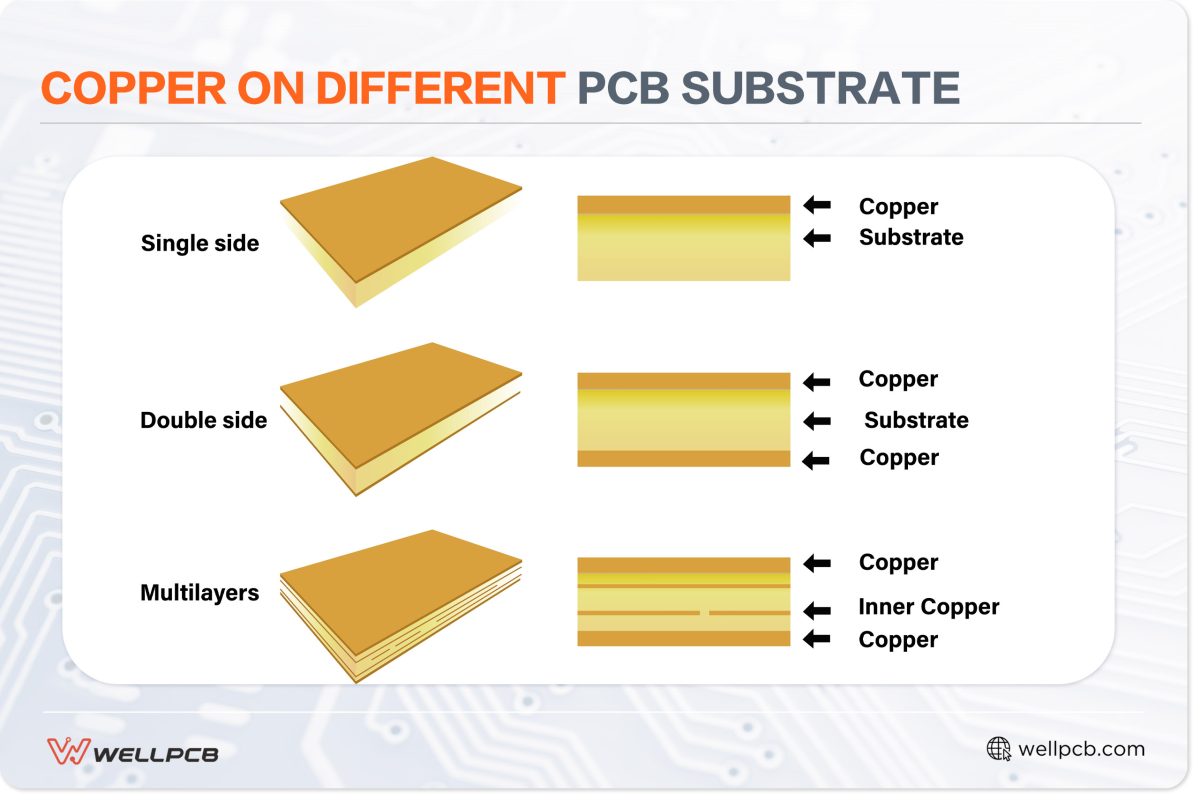
Utilize thermal via arrays in your PCB design
An effective PCB thermal management technique is to use thermal pads and copper reliefs on active components to direct heat toward the heatsinks, where airflow then spreads across the surface.
Key considerations for using thermal vias include:
Structure
Always select a diameter that’s large enough for efficient heat transfer. The surrounding pad should provide an effective thermal and electrical connection. Vias are typically plated with copper.
Limitations
While thermal vias facilitate even heat transfer from sensitive components to other PCB parts, they add complexity to PCB fabrication, which increases costs. Their effectiveness also depends on their size and spacing.
Placement
For optimal performance, place thermal vias directly under high-heat components, near heat sources, or in distributed arrays when multiple heat sources are present.
Save Time in the Long Run With Thermal Simulations
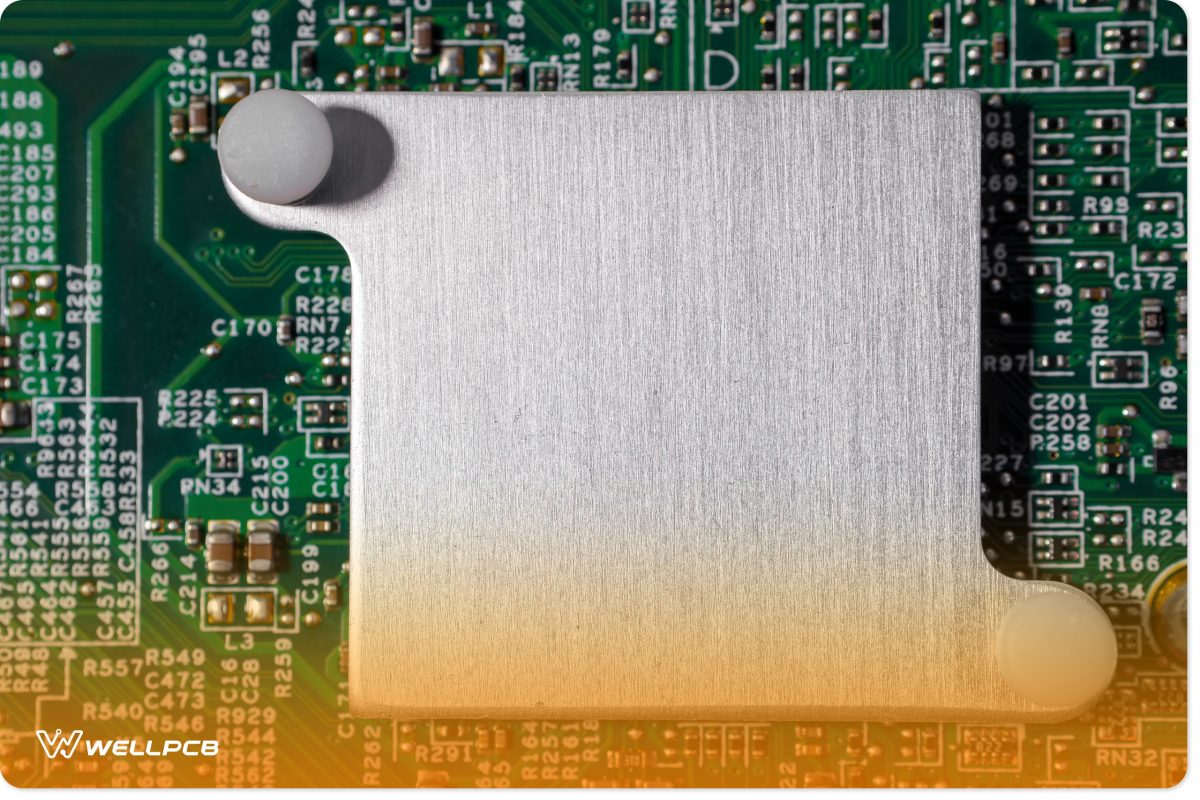
Thermal simulation allows designers to visualize heat distribution, identify sensitive heat areas, and make necessary design adjustments.
By modeling the heat behavior of PCB designs in various operating conditions, they can identify how heat will be distributed and accumulated across the PCB board.
Software tools like Altair Electronic Desktop, Hypertherm, ANSYS, and Siemens NX are commonly used for these simulations.
After running a thermal simulation, designers can identify components that operate at high temperatures and analyze whether they are at risk of overheating.
Based on the results, they can modify the PCB design to improve heat dissipation, such as adding copper traces, integrating heat sinks, repositioning high-power components, and redistributing heat sources to prevent clustering in high-temperature areas.
Early detection of hotspots helps mitigate potential problems, optimize performance, validate design decisions, save time and cost, and prevent delays in prototyping and production.
Work With a PCB Assembly Service for the Best Results
For high-power applications, effective thermal strategies are crucial for performance and reliability.
Partnering with a professional PCB assembly service like WellPCB helps ensure optimal results.
Our robust approach to PCB thermal management includes:
- Conducting thermal analysis during the design phase
- Using high-quality materials and advanced manufacturing techniques
- Performing rigorous testing to meet quality standards
- Detailed inspection and certifications to prevent defects
- Integrating effective thermal management solutions
- Maintaining a controlled manufacturing environment to regulate temperature fluctuations
- Offering tailored solutions to meet specific safety and thermal requirements
Visit WellPCB for more information on how to ensure your custom PCB layout excels in safety and thermal efficiency.
Need expert advice on thermal management for your PCB? Contact WellPCB today for personalized advice or to request a quote.





